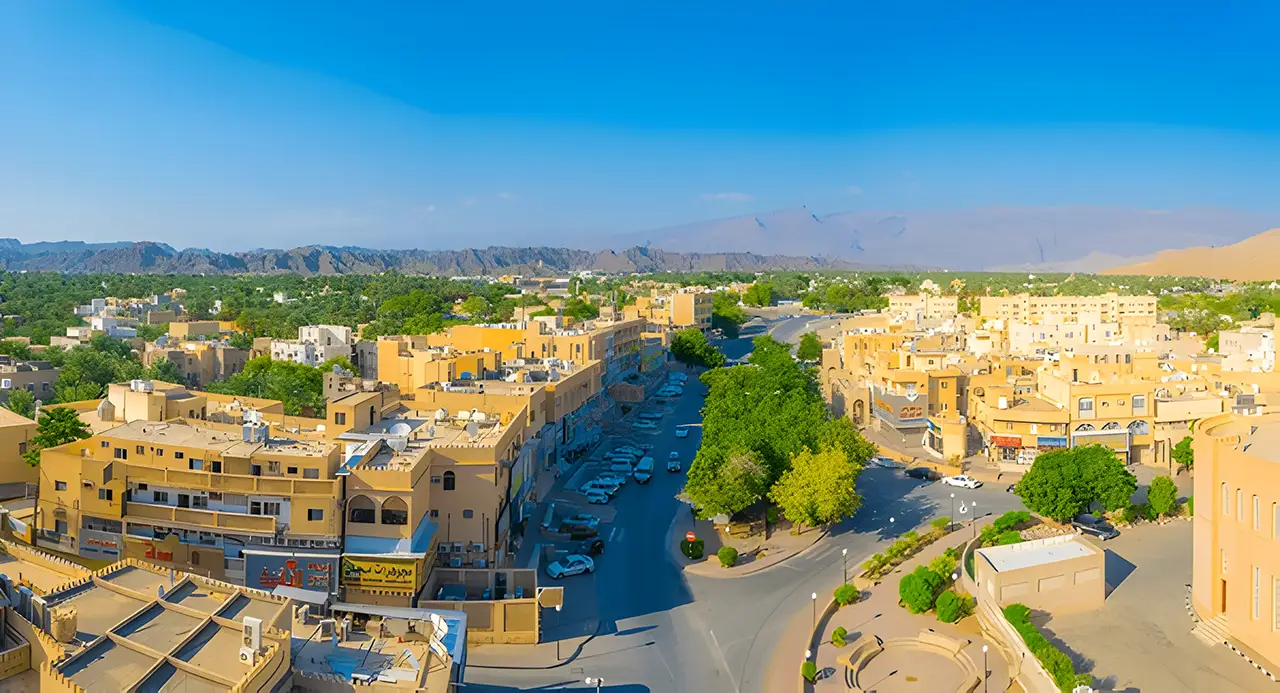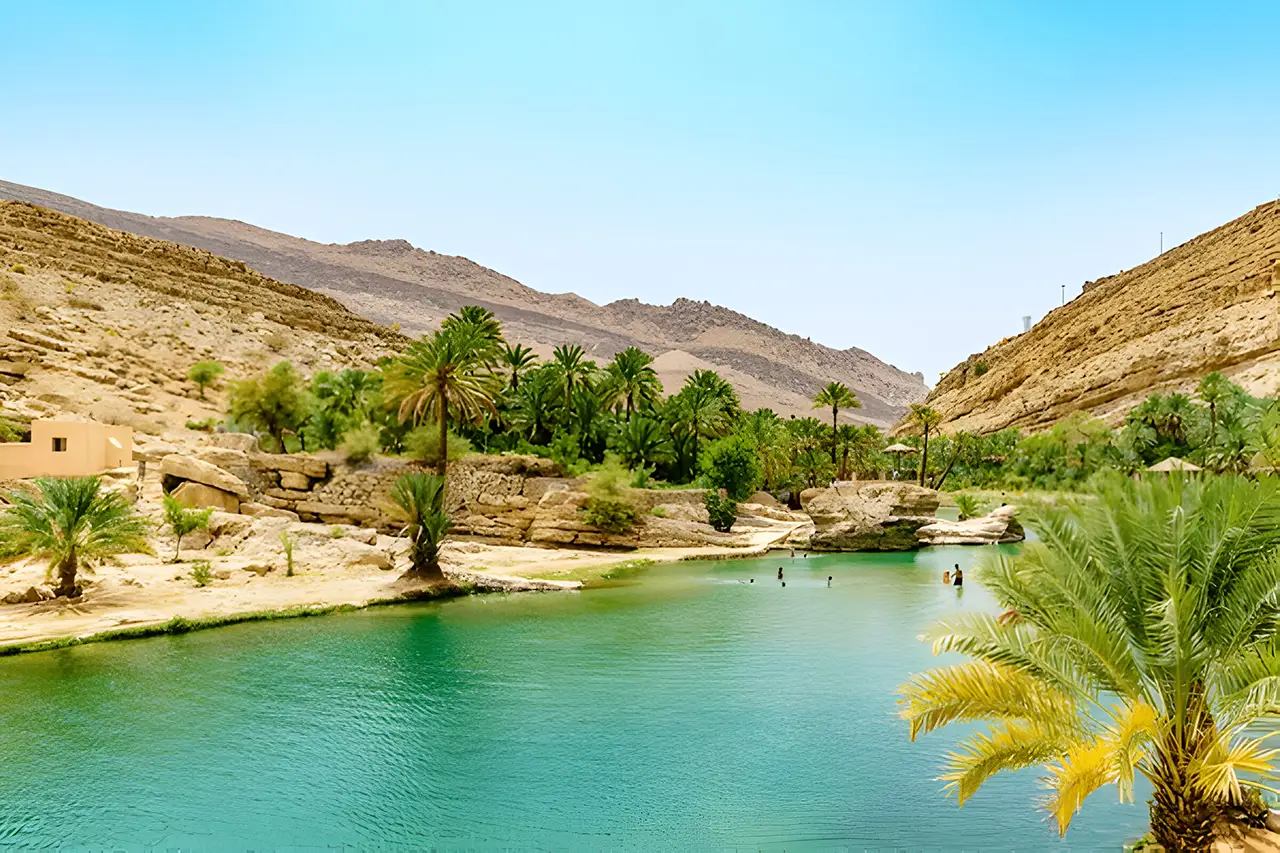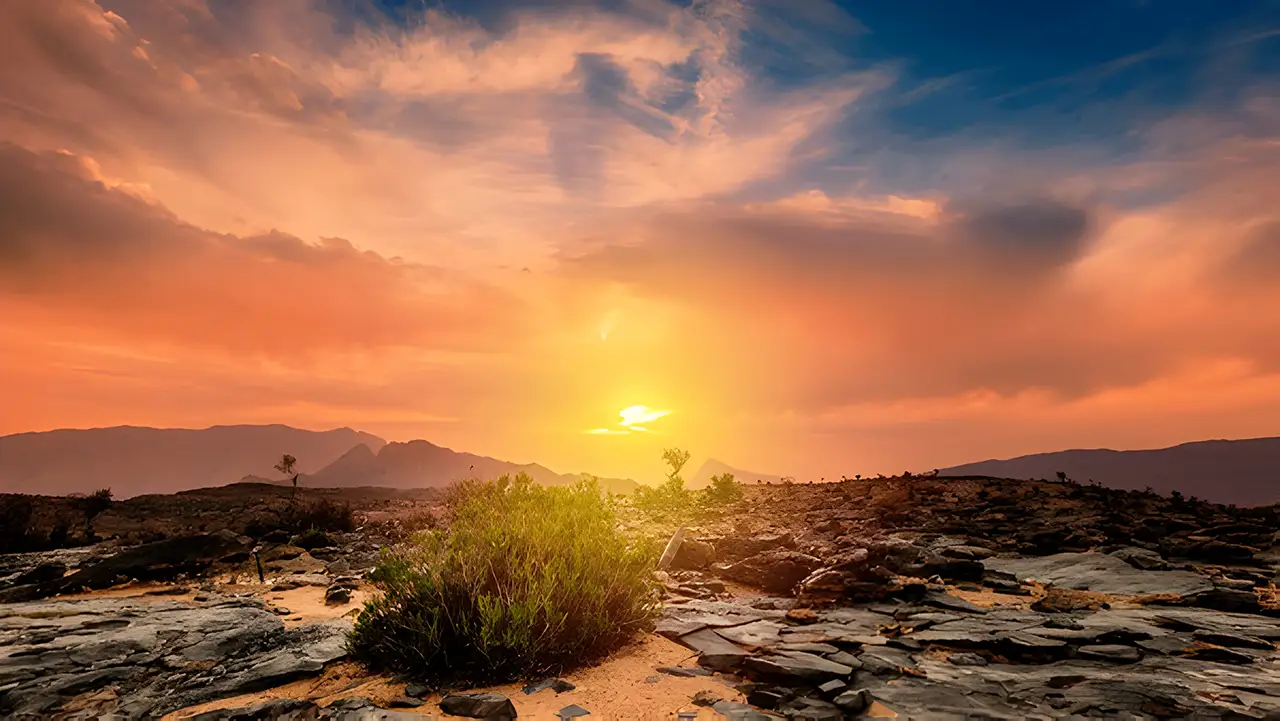Oman boasts a diverse climate that varies across its distinct regions, making it an appealing destination for travelers throughout the year. The interior features a subtropical desert climate, while the mountains offer more temperate conditions, and the coast experiences a warm, arid climate. The best time to visit Oman is between October and April when temperatures are cooler and more comfortable, ideal for exploring the country’s natural and cultural attractions. Depending on the time of visit, travelers can experience Oman’s unique landscapes and diverse climates, each offering its own distinct charm.
Coastal Areas
The coastal regions of Oman, particularly in the north, experience warm and arid conditions. Summers are particularly humid, with temperatures often exceeding 40°C (104°F) in cities like Muscat. The monsoon season, known as Khareef, occurs in the southern region of Dhofar, bringing cooler temperatures and lush greenery.

Mountains
The mountains of Oman, such as the Hajar Mountains in the north and the Dhofar Mountains in the south, enjoy a more temperate climate. Temperatures remain calm during the day, with highs around 24°C (75°F), and can drop up to 5°C (41°F) at night. These regions also experience higher precipitation levels, with the slopes receiving around 300mm of rain yearly.
Deserts
The interior of Oman, including the desert plain and the Empty Quarter, has a warmer and drier climate than other regions. Temperatures can exceed 50°C (122°F) between April and October. However, unlike true deserts, which experience significant temperature fluctuations between day and night, desert plains maintain high temperatures throughout the day and night.
Temperature Ranges
Oman’s temperature ranges vary significantly throughout the year. The hottest months are June to August when the maximum temperature can reach 50°C (122°F) in the interior. The most excellent months are December and January, with an average temperature around 13°C (55°F) in Muscat and potential frost and even snow in the mountains.
The best time to visit Oman is usually between October and April, when temperatures are pleasant, between 25°C (77°F) to 32°C (90°F), and rainfall is minimal. This period is ideal for outdoor activities, sightseeing, and exploring the country’s diverse landscapes and cultural attractions.
By familiarizing themselves with Oman’s climate and temperature variations, travelers can effectively plan their visits and enjoy their time in this enchanting Middle Eastern destination.
A Seasonal Guide for Oman Tour
Understanding the best time to visit Oman is crucial when planning a trip. This beautiful country offers diverse landscapes, rich culture, and a variety of activities throughout the year. Each season presents unique experiences, so let’s discuss the best times to explore Oman.
Peak Season: October to March
The peak season in Oman runs from October to March. The weather is pleasantly mild during this time, making it ideal for outdoor activities.

Weather Conditions: Temperatures range from 17°C to 35°C (63°F to 95°F). The cooler evenings are perfect for exploring.
Popular Activities:
- Hiking: Discover stunning trails in the Hajar Mountains. The cooler weather makes hiking enjoyable.
- Historical Sites: Visit ancient forts and palaces like the Nizwa Fort and Sultan Qaboos Grand Mosque without the sweltering heat.
- Local Festivals: Experience vibrant local culture during events like the Muscat Festival, which showcases Omani traditions, crafts, and food.
This season attracts many tourists, so booking accommodations and tours in advance is wise.
Shoulder Season: April to May
The shoulder season occurs in April and May. This period marks a transition as temperatures rise, but travelers remain comfortable enough to travel.
Weather Conditions: Expect temperatures between 25°C to 40°C (77°F to 104°F). Mornings and evenings are still pleasant.
Events and Festivals:
- Muscat Festival: This annual event usually occurs in February and March, but early April may still feature related activities. Travelers can enjoy cultural performances, food stalls, and art exhibitions.
- Outdoor Activities: Best time for desert safaris or beach outings before the heat intensifies.
During this time, travelers can enjoy fewer crowds, making it an excellent option for those seeking a quieter experience.
Off-Peak Season: June to September
The off-peak season lasts from June to September. This period is characterized by extreme heat, which can significantly impact travel plans.
Weather Conditions: Temperatures often exceed 40°C (104°F), particularly in the interior. The temperature can be challenging for outdoor activities.
Alternative Destinations:
Salalah: The Salalah Tour runs from June to September during the khareef (monsoon) season. This region experiences cooler temperatures and lush landscapes, making it a refreshing escape from the heat.
Indoor Activities: Explore museums, shopping malls, and local markets in air-conditioned comfort.
While the heat can be intense, those planning wisely can still enjoy Oman’s charm this season.
A Month-by-Month Guide
Knowing the best time to visit Oman is essential for maximizing your experience when planning a trip. Oman’s climate varies significantly throughout the year, offering unique opportunities for travelers. This guide will break down each month, highlighting the weather conditions, activities, and events that make Oman a fascinating destination.
January to March: The Best Time to Visit Oman
January to March are among the best times to visit Oman. The weather is cool and comfortable during this period, making it ideal for outdoor activities.

Weather Conditions: Average temperatures range from 17°C (63°F) to 30°C (86°F). The pleasant climate encourages exploration.
Activities:
- Outdoor Adventures: Families and tourists can enjoy hiking in the Hajar Mountains. Trails like Wadi Shab and Wadi Bani Khalid offer stunning views and refreshing water pools.
- Cultural Experiences: Visit historical sites such as the Nizwa Fort and Bahla Fort. These sites provide insight into Oman’s rich heritage.
- Local Festivals: The Muscat Festival typically occurs in January and February. This vibrant event showcases Omani culture through music, dance, and traditional crafts.
This time of year is perfect for families, as the comfortable temperatures allow for enjoyable outings without the risk of overheating.
April to May: Transition to Warmer Weather
April and May mark the transition from cooler to warmer weather in Oman. While temperatures begin to rise, the beauty of the landscape makes this a lovely time to visit.

Weather Conditions: Expect temperatures to range from 25°C to 40°C (77°F to 104°F). Mornings and evenings remain pleasant.
Activities:
- Photography Opportunities: The blooming flowers in the Al Hajar Mountains create stunning backdrops for photography. Capture the vibrant colors against the rugged mountain terrain.
- Outdoor Activities: Enjoy the mild weather for desert safaris and beach outings. The beaches near Muscat are perfect for relaxation and water sports.
- Cultural Events: While the Muscat Festival wraps up in early April, many local markets and cultural events continue. Explore the vibrant souks for unique handicrafts and traditional Omani foods.
This shoulder season offers fewer crowds, making it an excellent time for those who prefer a quieter experience.
June to August: The Hottest Months
June to August brings extreme heat to Oman, making outdoor activities challenging. So, this is not the best time to visit Oman. However, there are still ways to enjoy the country during these months.
Weather Conditions: Temperatures often exceed 40°C (104°F), especially in the interior regions. The coastal areas are slightly more relaxed but still hot.
Challenges:
- Heat Management: The intense heat can limit outdoor activities. Staying hydrated and avoiding the sun during peak hours (10 AM to 4 PM) is essential.
- Alternative Activities:
- Indoor Attractions: Visit the Sultan Qaboos Grand Mosque, one of the largest mosques in the world. Its stunning architecture and serene atmosphere provide an excellent escape from the heat.
- Shopping and Dining: Explore the air-conditioned malls in Muscat, such as the Oman Avenues Mall, Mall of Oman, and Muscat Grand Mall. Enjoy local foods at various restaurants and cafes.
- Visit Salalah: Head to Dhofar, where the khareef (monsoon) season brings cooler temperatures and lush landscapes. This area is famous for its greenery and waterfalls during the summer months.
While the heat can be intense, planning indoor activities and visiting cooler regions can make your trip enjoyable.

September to October: Gradual Cooling
As summer fades, September and October bring a gradual cooling to Oman. This transition makes it an appealing time for travelers.
Weather Conditions: Temperatures start to drop, ranging from 25°C (77°F) to 35°C (95°F). The weather becomes more favorable for outdoor exploration.
Activities:
- Return of Tourists: As the weather improves, more tourists return to Oman, making it a lively time to visit famous attractions.
- Outdoor Adventures: Enjoy hiking, camping, and exploring Oman’s natural beauty. The cooler temperatures are perfect for visiting places like Jebel Shams, Oman’s highest peak.
- Cultural Events: Check local calendars for festivals and events. The return of cooler weather often coincides with various cultural celebrations.
This period is ideal for those who want to experience Oman without the extreme heat of summer.
A Comprehensive Guide for Oman Tour
Oman, a jewel in the Arabian Peninsula, is famous for its landscapes, rich culture, and warm hospitality. If you’re planning a trip, understanding the best time to visit Oman is crucial for maximizing your experience. This guide will explore the climate, cultural events, festivals, and practical travel tips to help you plan your perfect getaway.
Understanding Oman’s Climate
Oman’s climate varies significantly across its regions. The coastal areas experience high humidity, while the interior regions can be extremely hot. The best time to visit Oman generally falls between October and April, when the weather is mild and pleasant.
Key Cultural Events and Festivals
Oman is rich in cultural heritage, and its festivals are a great way to experience the local traditions. Here are some key festivals to consider when planning your visit:
Muscat Festival (January-February)
The Muscat Festival is one of the most significant cultural events in Oman. It showcases Omani culture through art, music, and food.
- Activities: The festival features traditional performances, exhibitions, and food stalls. Visitors can enjoy fireworks, camel races, and various entertainment options.
- Tips: The festival is held during the cooler months, making it a perfect time to explore outdoor activities and cultural displays.
- Eid al-Fitr (Dates Vary): Eid al-Fitr signifies the conclusion of Ramadan, the sacred month dedicated to fasting. It is a time of celebration and feasting.
- Cultural Significance: Families gather to pray, share meals, and exchange gifts. It is a time of joy and gratitude.
- Travel Considerations: The dates vary based on the lunar calendar, so check the expected dates before planning your trip. In 2024, Eid al-Fitr is expected to be celebrated on April 10.
Salalah Tourism Festival (Mid-July to August)
This festival celebrates the khareef season in Salalah, transforming the region into a lush oasis.
- Activities: The festival includes cultural shows, music, food stalls, and family-friendly activities. It attracts locals and tourists looking to enjoy the cooler weather and vibrant atmosphere.
- Unique Experience: The khareef season offers a different side of Oman, with green landscapes and refreshing temperatures.
- Plan: Book your tours and accommodations in advance, especially during peak seasons (October to March). This ensures you secure the best prices and availability.
- Flexible Dates: Adjust your travel dates to be adaptable to benefit from reduced rates in the shoulder season (April to May).
What to Pack
- Clothing: Pack lightweight, breathable clothing for the summer months. In cooler months, a light jacket or sweater is advisable for evenings.
- Footwear: Comfortable, supportive footwear is essential for navigating city streets and hiking paths
- Sun Protection: To shield yourself from the sun’s rays, especially during the warmer months, remember to pack sunscreen, sunglasses, and a hat.
Local Customs
- Cultural Etiquette: Omanis are known for their hospitality. Always greet people with a smile and a polite “salam” (hello).
- Respect During Ramadan: If you visit during Ramadan, respect local customs. In Nepal, it’s customary to refrain from eating, drinking, or smoking in public during daylight hours.
- Dress Modestly: While Oman is relatively liberal, it’s best to dress modestly, especially in rural areas and during religious events.
Conclusion
Understanding the best time to visit Oman allows you to plan a trip that aligns with your interests and preferences. Whether you’re drawn to the cultural richness of the Muscat Festival, the vibrant atmosphere of Eid al-Fitr, or the lush landscapes of Salalah during the khareef season, Oman offers something for everyone.
By considering the climate, cultural events, and practical travel tips, you can create a memorable experience in this beautiful country. From exploring historical sites to enjoying the warm hospitality of the Omani people, your trip to Oman will surely be unforgettable. Plan wisely, pack appropriately, and prepare to explore the wonders of Oman!




